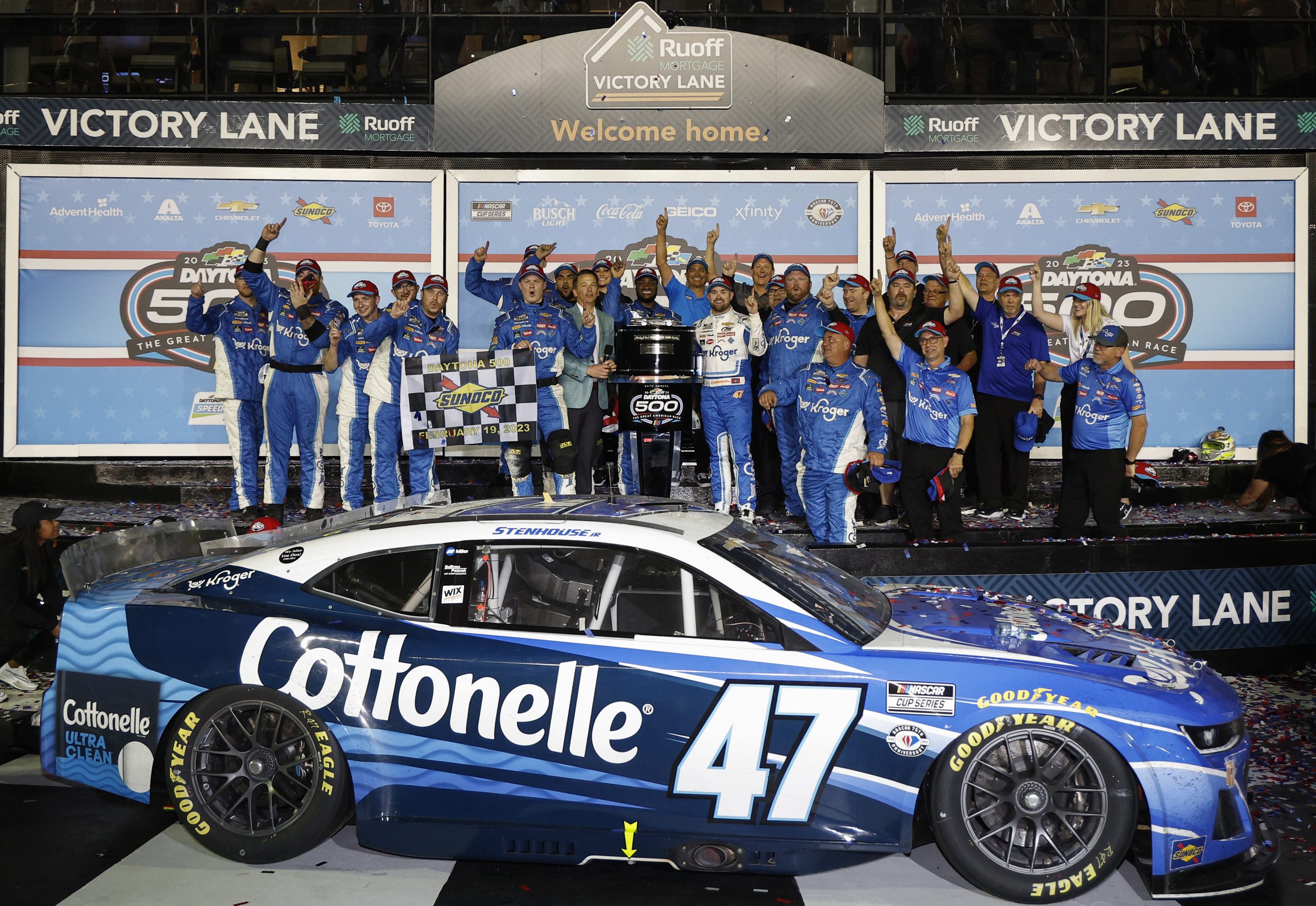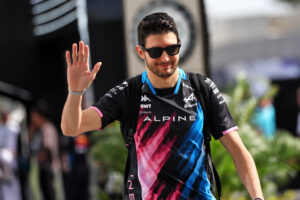The 75th season of NASCAR opened with Ricky Stenhouse Jr. shocking the world to win the 65th running of the Daytona 500.
With lead changes, massive wrecks, and side-by-side action for nearly the entire race, the 65th Daytona 500 started NASCAR’s diamond anniversary season with a bang. In the end, it was underdog Ricky Stenhouse Jr. that emerged victorious, snapping a 199-race winless streak.
1. Ricky Stenhouse Jr. wins the Great American Race for JTG Daugherty Racing
Without question, Ricky Stenhouse Jr. is one of the most scrutinized drivers in NASCAR. Often referred to as “Wrecky Spinhouse,” he is known for his overaggressive racing style, which usually results in him crashing his car.
He entered the Cup Series in 2013 with Roush Fenway Racing following back-to-back Xfinity Series championships. With Roush, Stenhouse Jr. consistently failed to live up to his potential. Aside from a two-win season in 2017, he has never won in any other season in his career and had only finished inside the top 20 in points three times.
The lack of performance led him to be ousted from Roush before 2020 and join JTG Daugherty Racing. Lackluster 2021 and 2022 seasons led many to expect the same in 2023 for Stenhouse Jr.
Changing the narrative
Despite all of the criticisms and low expectations, Stenhouse Jr. overcame them all on Sunday to win the Great American Race. It was his first win since July 2017 at Daytona. For JTG, it was their first win since A.J. Allmendinger won at Watkins Glen in 2014.
Stenhouse Jr. uncharacteristically ran a clean race. He stayed near the front, evaded a few wrecks, and did not make any of the aggressive moves he has become known for. By the first overtime, Stenhouse Jr. found himself firmly inside the top ten. When Austin Dillon and Kyle Busch fell from the lead, Joey Logano was a sitting duck out front. This allowed Stenhouse Jr. to take advantage of a huge push from Kyle Larson to jump to the lead. The second Big One soon erupted, but the move set up the #47 as the leader for the ensuing restart.
During the second overtime restart, Stenhouse Jr. and Larson remained side-by-side for the lead for nearly an entire lap. Stenhouse Jr. jumped out to a huge lead, but this allowed Logano and Larson to each generate huge runs as the field took the white flag.
The winning move was Stenhouse Jr. throwing a huge block on Larson and stealing his momentum. Larson was then stranded in the middle, which eventually set off the race-ending caution. The block allowed Stenhouse Jr. to narrowly get an edge on Logano when the caution flew, giving the #47 the shocking victory.
This win will likely be the defining moment of Stenhouse Jr.’s and JTG Daugherty’s careers in NASCAR. They have been competitive at the superspeedways for the last couple of years, but they finally found a way to finish the job on Sunday. The victory also virtually locks Stenhouse Jr. into the Playoffs. It would be JTG’s first Playoff trip since 2014 with Allmendinger and Stenhouse Jr.’s first since 2017.
2. The Big Ones decimate Daytona 500 hopes for several notable teams and drivers
It had been a great run for Stewart-Haas Racing. All four cars (Kevin Harvick, Aric Almirola, Chase Briscoe, Ryan Preece) were near the front all race long and appeared to be legitimate contenders. Unfortunately, all four were caught in the first Big One with about 20 laps to go in the race.
A stack-up on the high side led to a huge wreck that collected the entire SHR camp. Briscoe and Preece were forced to retire for the race. Almirola (21st) and Harvick (12th) survived until being caught in the final Big One.
The wreck was also catastrophic for rookies Ty Gibbs and Michael McDowell.
Despite being a massive crash, it paled in comparison to the second Big One that occurred during the first overtime. After losing the front row, Austin Dillon got loose and collected nearly the entire pack. Notable drivers in the wreck included William Byron, Denny Hamlin, Austin Cindric, Ross Chastain, Noah Gragson, and seven-time champ Jimmie Johnson.
The third and final Big One occurred on the last lap of the race. Kyle Larson, who went three-wide between Ricky Stenhouse Jr. and Joey Logano for the lead, got loose and wrecked essentially the rest of the field. The only cars to survive the carnage unscathed were the top three finishers in the race: Stenhouse Jr., Logano, and Christopher Bell.
3. Next Gen parity continues with improved superspeedway racing
Despite being the longest Daytona 500 in history at 212 laps, the racing was wildly entertaining. There were 53 lead changes among 21 drivers. Cars were side-by-side for nearly the entire event and it was never clear who would emerge victorious.
There was also none of the manufacturer dominance that has been seen in recent years, namely from the Ford camp. Fords like Joey Logano, Aric Almirola, Brad Keselowski, and Chris Buescher were strong, but so were the Chevys and Toyotas. Ricky Stenhouse Jr.’s win was also the first for Chevy in the Daytona 500 since Austin Dillon’s triumph in 2018.
Last year’s superspeedway racing was criticized for being too boring or too chaotic. It seemed that drivers would either stay in a single file most of the race or would constantly wreck each other. At least after Sunday, these issues seem to be resolved in the new year. Aside from the chaos of the last few laps, the racing was entertaining and clean for the majority of the event.
The lone criticism of the race was the ending. As great as it was to see the underdog Stenhouse Jr. finally break through, the caution made the conclusion of the race feel very anti-climactic. The caution was the right call by NASCAR, but it nevertheless would have been better to see the drivers duke it out to the finish line.
4. Can RFK keep up the momentum?
Although their results did not show it, RFK Racing made a statement on Sunday. Between both of their drivers, they led 74 laps in the event. Owner-driver Brad Keselowski led a race-high 42 laps and Chris Buescher was out front for 32 laps.
It looked like it was their race to lose before the late-race cautions and restarts left the field in shambles. They were left out to dry by RCR teammates Kyle Busch and Austin Dillon. This led to both RFK cars fading to the back half of the top ten. Both cars still managed to survive until the last lap wreck, when each got caught up in the massive crash triggered by Kyle Larson getting loose in the middle groove.
Buescher still found a way to finish fourth. Unfortunately, Keselowski was not as lucky, making hard contact with the wall and finishing 22nd as a result. Despite the disappointing finish, the RFK machines each showed serious speed. They may have both failed to qualify for this season’s Busch Light Clash, but the team made serious strides in the second half of 2022 and this trend continued at the Daytona 500.
The one issue is this is exactly what happened to RFK last year at Daytona. Keselowski and Buescher swept the Duels before having a respectable showing at the Great American Race. Optimism was high, but then were terrible the majority of the season.
With their success at the end of last season, RFK’s effort at this year’s Daytona 500 seems more legitimate than last season’s. However, only time will tell if this team has truly taken a step forward or if they will remain near the back of the pack week in and week out.
5. Favorites eliminated early
Many expected Ryan Blaney and Chase Elliott to be competitive on Sunday. Blaney won the August Daytona race in 2021 and has nearly won the Daytona 500 a number of times. Meanwhile, Elliott is always competitive at the superspeedway. Through almost two stages of the race, neither was dominant, but each appeared to have enough to contend for the win. Then, disaster struck both star drivers.
With about ten laps left in stage two, Tyler Reddick got loose in front of Kevin Harvick. Harvick ran into the back of Reddick, spinning him into Blaney. This forced Blaney into the wall. As Reddick spun in front of the field, he collected several cars, including Erik Jones and Elliott.
The wreck ended the day for Reddick, Jones, and Elliott. Blaney was able to continue, but his car was junked and he ran most of the race multiple laps down. However, he kept grinding, survived the Big Ones, and managed to finish eighth.






